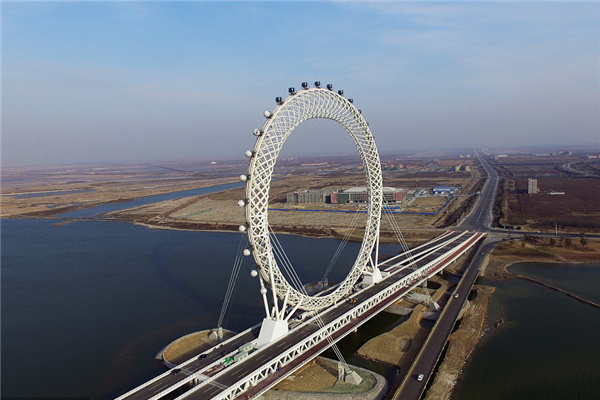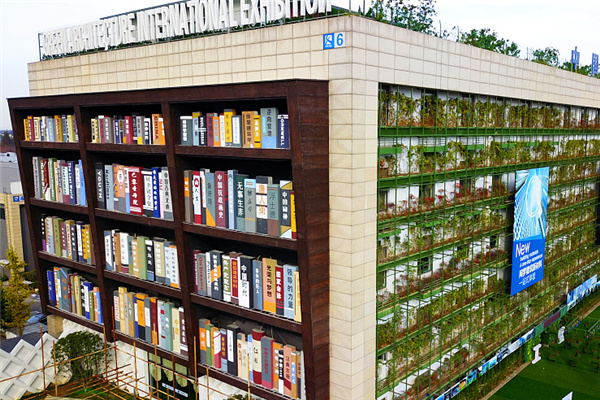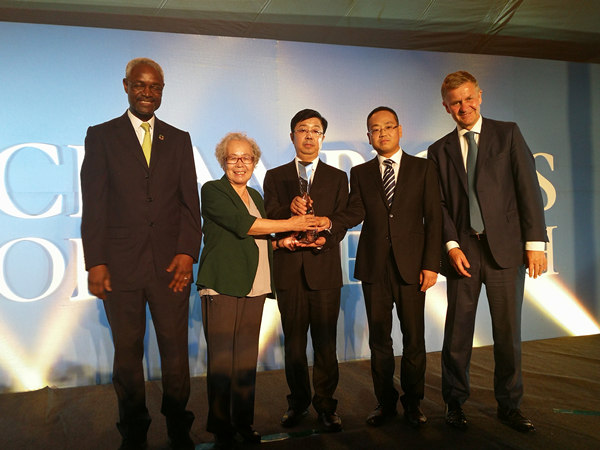

|
Lingwu Power Station in Ningxia Hui autonomous region. |
Jiao Hongqiao, a 40-year-old chief engineer of a propylene plant of Shenhua Ningxia Coal Industry Group, extends his arm at the models in front of him, his gestures growing more animated as he explains to the reporters how he plans to transform small factory models into the real thing within five to 10 years.
"This world's largest DME (dimethyl ether, a clean-burning hydrocarbon fuel) plant with annual capacity of 210,000 tons will be finished by early 2009," he says proudly, pointing at a model factory directly in front of him. "That coal-to-oil project is still at its R&D phase and that alkene project will be Ningxia's biggest when it is put into production by 2010," he says, stretching his arm while pointing at another two factories in the far corner of the table.
What Jiao proudly introduced to reporters gathered in Ningxia Hui autonomous region to witness the ground breaking ceremonies of eight energy-chemical projects on December 15 is only a small part of Ningxia's ambitious plan to become one of the country's top energy suppliers in no more than 10 years.
An estimated 300 billion yuan will be pumped into the region to construct an energy-chemical base in Ningdong area by 2020, the local government says. It will have power plants with 16,000 megawatts in capacity, coal mines able to produce 130 million tons of the fuel a year and coal-to-chemicals plants with an annual capacity of 20 million tons.
Ningxia is listed among the poorest provinces/municipalities/autonomous regions in China, with its per capita GDP only higher than those of Tibet and Qinghai. However, the region decided to shake off the past shadow by first shaking up its energy industry.
Ningxia currently has 30 billion tons of proven coal reserves, of which 27.3 billion are at Ningdong, the local government says.
Newly initiated projects
Chinese energy companies including State Grid Corp of China and Huadian Power International Corp started building projects with a combined investment of more than 50 billion yuan in Ningdong recently.
A construction start-up ceremony took place on December 15 for three power plants, three coal mines, one electricity distribution line and one coal-to-petrochemical plant.
Those projects, located in the 3,500 square-kilometer Ningdong Energy-Chemical Base, are an important part of the government efforts to develop resources in western China and will help China increase the domestic demands, Zhang Guobao, head of the National Energy Administration, said at the ceremony. The construction of the energy-chemical base is now regarded as the local government's top priority.
State Grid, China's biggest power distributor, will invest 10.4 billion yuan in building a 660-kilovolt transmission line linking coal-fired and hydropower stations in Ningxia with Qingdao in the eastern province of Shandong, the energy administration says in a statement. The line, to be completed by 2010, will help ease the pressure to transport the dirty coal from western China to Shandong, the local government says.
"The financial crisis has weakened the coal prices and electricity demand in China, providing an opportunity to restructure the country's energy industry," Zhang says.
Hong Kong-listed Huadian Power and the local company of Ningxia Power Generation Group will lead the construction of three coal-fired electricity plants worth 16.4 billion yuan in the region, the local government says. The plants have a total capacity of 4,400 megawatts.
A total investment of 7.6 billion yuan will be made to construct three coal mines with a combined annual capacity of 22 million tons, it says.
One 1.7-billion-yuan plant also started construction to turn coal into petrochemicals.
China's economy expanded at its slowest pace since 2003 in the third quarter as export orders shrank and industrial production waned. The Chinese government unveiled a 4-trilion-yuan stimulus plan in November to spur the economy as the world slowed down into a recession.
The Chinese government is speeding up approvals for energy projects in order to spur the economy.
More job opportunities
Fledging industrial structures, sharply declining resource prices and a weaker capability to handle risk and social conflict make the western and middle regions more vulnerable to global financial woes, says Du Ying, vice-minister, National Development and Reform Commission.
Du believes the weaker economy in China's hinterlands won't provide enough job opportunities for migrant workers returning from bankrupt factories in East China, potentially giving rise to social conflicts. The central and the western regions are China's major labor exporters.
The eight new projects in the Ningdong area will help to create 45,000 jobs for the locals, says Qi Tongsheng, vice chairman of the Ningxia Hui regional government.
"The energy-chemical base will be beneficial to 60 to 70 percent of the local resident, and in addition, it will attract more talents to work here," Qi says.
Statistics show that the since the construction of Ningdong energy-chemical base began in 2003, it has directly and indirectly provided jobs to 20,000 locals.
By 2020, the annual GDP of Ningdong will reach 80 to 10 billion yuan, 50 percent more than the entire Ningxia's industrial output of 2007, predicts Yuan Jinlin, head of the Development and Reform Commission of Ningxia Hui autonomous region. "The energy base will create 750,000 jobs among cities along the Yellow River; in addition, it will help speed up urbanization and about 60 percent of Ningxia people will be city dwellers by 2020."
(China Daily 12/29/2008 page4)













